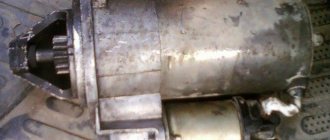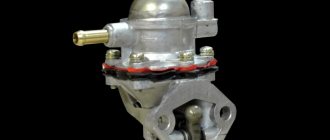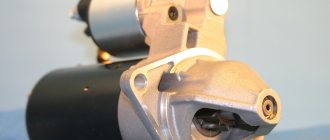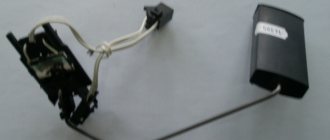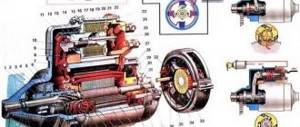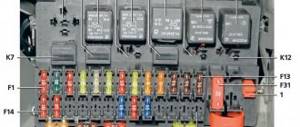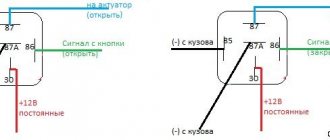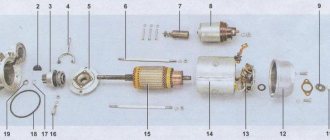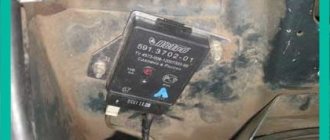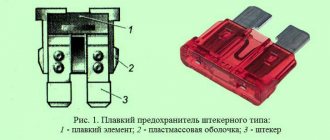Despite the fact that most modern motorists prefer to have their cars serviced and repaired in specialized centers, self-diagnosis of vehicles has not yet been canceled. In addition, a basic understanding of the machine’s structure will help to avoid deception on the part of unscrupulous craftsmen who diagnose a missing wiring as a breakdown of a serious component. And they “repair” this breakdown by simply tightening the contact.
One of the situations in which a car enthusiast must be observant is the moment when he starts the engine. In general, this is possible if the starter is working properly. The key role in whether the vehicle’s internal combustion engine starts is played by the solenoid or traction relay.
What is a starter solenoid relay?
This part is attached to the starter. It depends on it whether the flywheel can turn the trigger mechanism or not. As shown in the photo, the traction relay is part of the starter design.
Without this element, not a single modern electric starter works. There are many modifications of this element. However, the operation of the device is identical in all cases. The relay itself simultaneously performs several functions.
Purpose of the starter retractor relay
This part should not be confused with the starter relay, which is used by the ECU to activate the starting mechanism. The traction unit (this name is officially used by the vehicle manufacturer in the technical documentation) is installed directly on the starter housing and looks like a separate element, but on one side is firmly connected to the main device.
Solenoid relays in cars do the following:
- Provide a strong connection between the gear wheel and the flywheel crown;
- Hold the bendix in this position as long as the driver holds the key or start button in the extreme position;
- They ensure the closure of the electrical circuit contacts, which leads to activation of the starter motor;
- The bendix returns to its place when the driver releases the button or key.
Principle of operation
It all works like this: when the engine is not running, the armature of the retractor relay is pulled out of the housing due to the action of the spring on it. The same spring holds the Bendix and gear through the fork in a position where there is no engagement.
When the ignition key is turned to the start position, the solenoid relay is first activated.
The electrical energy supplied to the coils of the solenoid relay ensures the appearance of a magnetic field inside the housing.
This field acts on the armature, and it, overcoming the force of the spring, enters the body, after which the retracting coil is turned off and ceases to create a magnetic field, but in the retracted position the armature is held by the holding coil with its magnetic field.
In this case, the armature pulls the fork, which in turn moves the bendix forward along the rotor shaft, and its gear engages with the flywheel ring.
The armature, entering the housing, pushes the starter relay rod, and, moving, closes the contact plates of the positive terminals with each other.
Electricity from the battery is supplied to the brushes of the starter motor, and its rotor begins to rotate. And since the gear has already engaged, the rotor begins to rotate the flywheel.
POPULAR WITH READERS: Volvo VIDA 2011C spare parts catalog
After starting the power plant and turning the ignition key back, the power to the holding coil stops, its magnetic field disappears and the armature comes out of the housing under the influence of a spring.
At the same time, it disengages the bendix through the fork and stops acting on the relay rod. He, in turn, moving away, opens the contact plates, and the starter is completely turned off.
Design, types and features of solenoid relays
The solenoid has two windings. The most powerful is retractor. It is responsible for ensuring that the anchor overcomes the maximum resistance of all energized elements. The second winding of smaller wires simply holds the mechanism in this position.
To prevent the electric motor from being blown apart when the Bendix contacts the flywheel of an already running engine, the design of most modern starters has special overrunning clutches.
Also, solenoid relays differ in the type of housing. It can be collapsible or non-dismountable. Another difference between some modifications is in the control method. The system can activate only the starter drive or, together with it, also the circuit containing the ignition coil or other equipment.
Operating principle of traction relay
The relay operates according to the following scheme:
- The traction winding receives voltage from the power source;
- A magnetic field of such strength is formed in it that it sets the armature in motion;
- The armature moves the starter fork so that it engages the bendix and moves it towards the flywheel;
- The teeth of the drive wheel engage with the teeth of the rim located at the end of the flywheel;
- At the same moment, from the other end, the anchor moves the rod on which the “penny” or contact plate is attached;
- The plate connects the contacts, which are connected to the car battery using a bolted connection via wires;
- Voltage is supplied to the starter motor;
- At this moment, the retractor coil is deactivated, and the holding coil is switched on to replace it (it is active while the driver is trying to start the engine);
- When the key (or the “Start” button) is released, the voltage in the winding disappears, the springs return the rod to its place, opening the contact group, the battery is disconnected from the starter, the electric motor is de-energized;
- This time the armature no longer holds the starter fork;
- With the help of a return spring, the bendix is disconnected from the crown, which by that time should already be rotating due to the autonomous operation of the internal combustion engine.
This is how a classic traction starter works. Depending on the functionality, the device can connect additional equipment to the circuit, for example, an additional relay or ignition coil.
Concept and principle of operation of the starter relay
A starter solenoid or traction relay is a necessary attribute of every car. It works in conjunction with the engine starter and performs an important function. In addition to the starter relay, the engine starting mechanism contains a gear and a flywheel. It is through the starter relay that the gear and flywheel are engaged and disengaged at the moment of starting. This is necessary to ensure that the starter itself works correctly and lasts a long time.
The starter solenoid relay consists of such main components as a relay body, an armature, a spring, windings with an electromagnet and a pair of contacts.
The principle of operation of the starter relay is that when the ignition key is turned on, a magnetic field is formed, which moves the armature into the housing. Then the magnetic field ceases to act, but the coil creates its own field, which does not allow the armature to return to its original position. Then the bendix gear moves along with the armature, and finally it engages with the flywheel.
After this, the contact pairs close, resulting in the formation of a current that begins to rotate the rotor together with the flywheel. In order to unhook the gear together with the armature, the starter relay comes into action. With its help, the magnetic field is turned off, and thus the armature and the gear return to their original position.
Signs and causes of relay failure
The very first symptom of a broken traction relay is the inability to start the engine. In this case, strange sounds may be heard coming from the trigger mechanism. You don't need to be a professional mechanic to identify a broken starter. When you turn the key, the car will either not start, or it will take several attempts. Sometimes it happens that the engine is already running, the key is released, but the Bendix wheel does not disconnect from the ring gear.
There are not so many reasons for traction failures. Two of them are mechanical - the Bendix return spring is broken or the overrunning clutch is jammed. In the first case, the gear will not engage well or will not detach from the ring gear. In the second, the pull-in winding does not have enough power to overcome such resistance. As a result, neither the motor turns nor the bendix extends.
The remaining faults are related to the electrical circuit, so to find out what exactly the problem is, you need to arm yourself with the appropriate tools.
How to test the starter relay
First of all, the problem with the engine not working may be due to damaged wiring. Therefore, the check should begin with it. If it is in perfect working order, you should check the starter relay. There is a high probability that it simply does not work.
If a click is heard, but the engine does not start, you should check the functionality of the contact pairs. To do this, use a screwdriver to remove the terminal and connect it to the starter terminal. In this case, current must flow and if the motor fires, then the contact pairs are not damaged, and the problem lies in other parts.
A complete check of the starter relay also includes a voltage check, since a lack of energy causes the flywheel to not rotate sufficiently, and thus the engine cannot be started. In this case, you will need a special multimeter. One probe must be connected to the positive terminal, and the other to ground. Then you should turn the ignition key and look at the multimeter readings. If they are below the available standard, it means there is not enough voltage to start the engine.
All these procedures can be carried out without removing the starter from the car, which makes the work easier. However, if a complete inspection of the relay with its removal is required, you should remember the safety rules. The torque is quite strong, so it is best to place the device on the ground at a safe distance. Parts must also be disassembled with caution, as incorrect inspection can cause serious injury.
Checking the starter retractor relay
The retractor may have several breakdowns. They can only be eliminated after the device is disconnected from the motor. But before you do this, you need to carry out a few simple procedures. They can eliminate a "symptom" very similar to starter failure.
So here are the simple steps:
- We check the battery charging - if the starter clicks, but the flywheel does not turn, it means there is simply not enough energy;
- Electricity may not flow to the terminals due to oxidation at the battery terminals or other wire connections. Oxidation is removed and clamps are more firmly secured;
- Check the starter relay to see if it is working properly.
If the malfunction has not been eliminated by these actions, the mechanism is removed from the machine.
Starter removal procedure
First, the car needs to be driven into a pit, lifted on a lift, or driven onto an overpass. This will make it easier to get to the starter mount, although in some cars the engine compartment is so large that access to the starter is possible even from above.
The starter itself can be removed quite easily. First, you should unscrew the contact wires (they must be marked so as not to confuse the polarity). Next, the mounting bolts are unscrewed, and the device is already in your hands.
How to check the starter solenoid relay
The functionality of the retractor is checked as follows:
- The positive contact of the device is connected to the “+” terminal on the battery;
- We fix the negative wire to the negative terminal of the battery, and connect the other end of this wire to the starter housing;
- A clear click from the device indicates proper operation of the traction relay. If the starter does not start the engine, then the problem must be looked for in other components, for example, in the electric motor of the starting device;
- If there is no response, a breakdown has occurred in the relay.
Basic starter relay faults
Like any other part, the starter relay may experience technical problems with its operation. They may appear as follows. The most obvious cause of the malfunction is that the starter simply does not engage and thus the engine does not start. The opposite problem is that the starter does not stop working after the engine starts.
This also indicates a problem in the mechanism. Also, often the starter does not have enough revolutions to spin the flywheel and thus turn it on. Another cause for concern is the absence of a click when the ignition key is activated, which signals that the armature has been pulled into the housing and the gear is engaged with the flywheel. If it is not there, then the mechanism did not work. However, there are times when the click is triggered, but the starter device still does not work. The problem most likely lies in burnout of contact pairs.
There can be many reasons for the above problems. First of all, obvious wear of parts that prevent the starter from working correctly may catch your eye. In this case, the solution to the problem is to replace parts. Contact pairs or windings may also burn out, as mentioned above. To troubleshoot, as in the first case, a complete replacement of parts is necessary. In addition, the anchor may move into the hull with some delay and difficulty.
Repair of starter retractor relay
Most often, the traction relay is not repaired, since its elements are mainly enclosed in a non-separable housing. The only thing that can be done in this case is to carefully remove the folding of the lid with a grinder. Below it is a contact plate.
Often the malfunction consists of burning of the contact surface. In this case, the plate and contacts are cleaned with sandpaper. After repair work, the body is carefully sealed.
A similar procedure is performed with a collapsible modification. The only difference is the principle of disassembling and reassembling the structure.
If everything is in order with the contacts, but the traction does not work, then most likely there is a problem with the windings. In this case, the part is simply replaced with a new one. Repair of these elements is extremely rare, and then only by amateurs of handmade work.
Diagnostics without removing the starter using a multimeter
To do this, use a multimeter (tester) to first sequentially measure the voltage at the terminals of the battery, disconnected from the vehicle’s on-board network. It is approximately 12.7 V. If the device readings are less than 12 V, the battery is considered to be severely discharged and is not suitable for further testing.
Next, restore the normal connection of the wires and measure the voltage at the battery terminals and relay contacts. Compared to the previous case, it changes by no more than 0.1 V and will be equal at both control points. Turn the key to the start position. The voltage at the relay contacts should not fall below 12 V. Otherwise, the connecting wires are most likely faulty; it is possible that one or more contacts in the current flow circuit have burnt out.
This is interesting: Replacing the front wheel bearing
Selecting a new solenoid relay
Finding a new retractor for an effective start of the power unit is not the most difficult task. The choice is made in accordance with the manufacturer's recommendations. In the store catalog, the company can offer different options for a specific starter.
You can also dismantle the starter and bring it to the store. There experts will help you choose the appropriate modification.
First of all, the choice should be made on the original spare part, even if it is not manufactured at the factory where the car was assembled. Basically, automakers only assemble vehicles, and spare parts for them are manufactured at other factories and, most often, by other companies.
It is worth considering that retractors for different starters are not interchangeable. They differ from each other not so much in design as in drive power and the principle of circuit connection. For this reason, you should be careful when choosing a new spare part.
